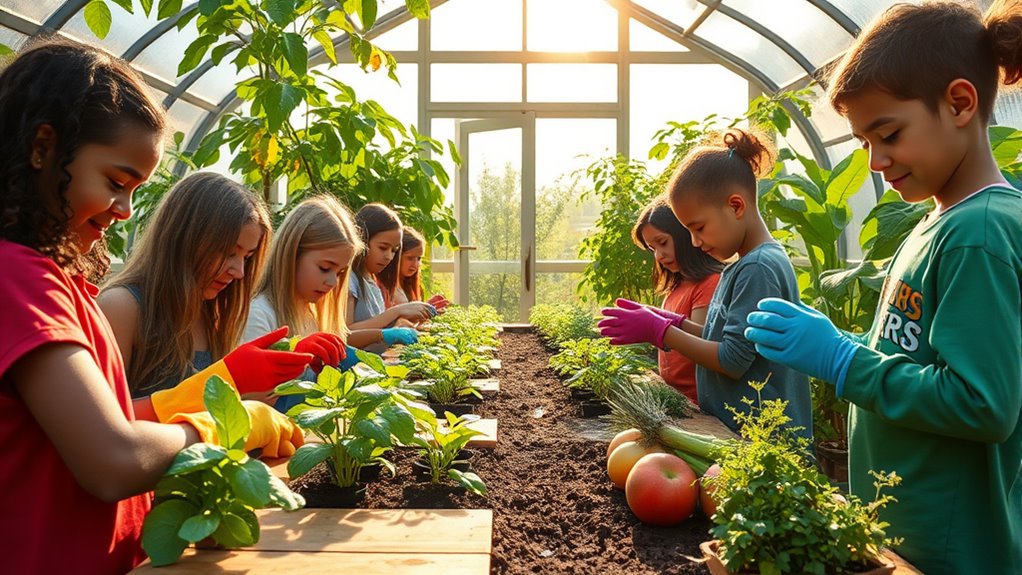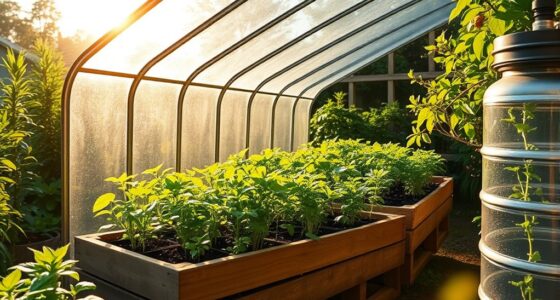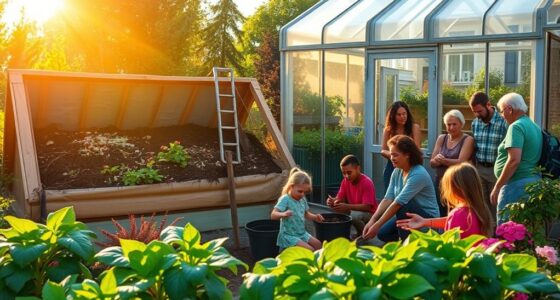Greenhouses in education offer hands-on learning that cultivates sustainability skills in students. By engaging with plant biology, students explore topics like photosynthesis and environmental science while applying engineering concepts to create efficient systems. These experiences foster critical thinking, creativity, and community connections. Through gardening and sustainability projects, students develop a lifelong responsibility for the environment. There's so much more to discover about how greenhouses can shape the next generation's approach to sustainability and innovation.
Key Takeaways
- Greenhouses provide hands-on learning experiences that enhance students' understanding of sustainability through practical applications in plant biology and environmental science.
- Interdisciplinary activities in greenhouses foster critical thinking and innovation, enabling students to solve real-world challenges related to sustainability.
- Engaging with sustainable practices, such as composting and hydroponics, promotes environmental awareness and responsible resource use among students.
- Community involvement in greenhouse initiatives strengthens local ties and fosters a collaborative approach to sustainability education and practice.
- Long-term participation in greenhouse projects cultivates a sense of environmental stewardship and prepares students to advocate for sustainable policies in the future.
The Role of Greenhouses in STEM Education
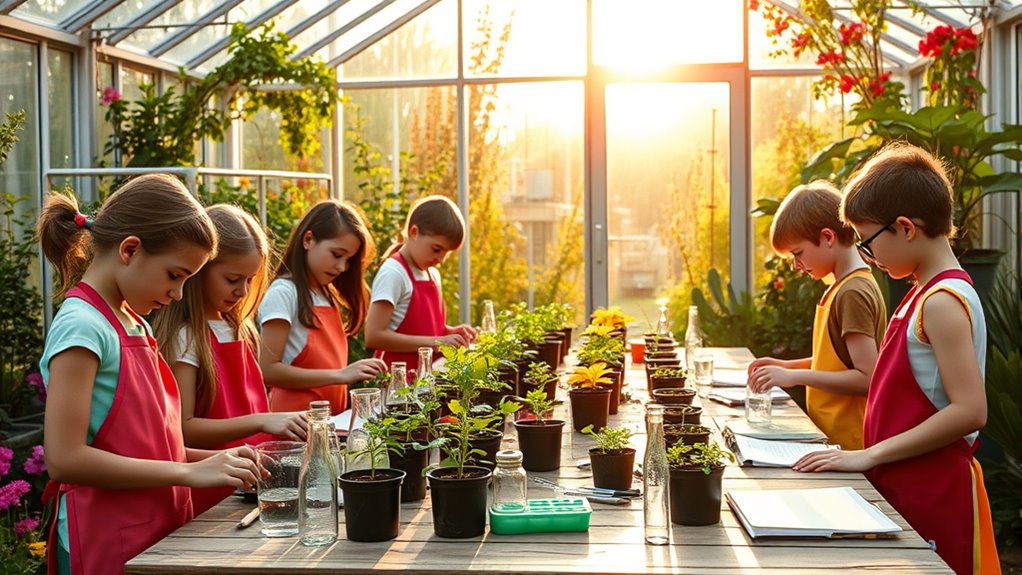
As students explore the world of greenhouses, they immerse themselves in a vibrant hands-on learning experience that enhances their understanding of STEM concepts.
Working in a controlled environment, you'll engage in activities like planting, monitoring growth, and collecting data. This practical approach sharpens your critical thinking and analytical skills as you analyze plant growth and environmental factors. Additionally, understanding wind resistance helps students recognize how environmental factors impact plant health and greenhouse stability. Engaging in these activities can also foster emotional well-being, similar to the benefits seen in pet therapy for individuals with cognitive decline. Furthermore, students can learn about season extension techniques that allow for year-round gardening, which is a crucial aspect of maximizing food production. Incorporating knowledge about natural remedies can also enhance students' understanding of sustainable practices in managing greenhouse environments.
Engage in hands-on learning by planting, monitoring, and analyzing growth to enhance your critical thinking and analytical skills.
You'll tackle real challenges, such as pest management and optimizing growth conditions, enhancing your problem-solving abilities.
Greenhouses also encourage interdisciplinary connections, blending biology, physics, and mathematics to foster a holistic understanding of scientific principles.
Promoting Environmental Awareness Through Greenhouses
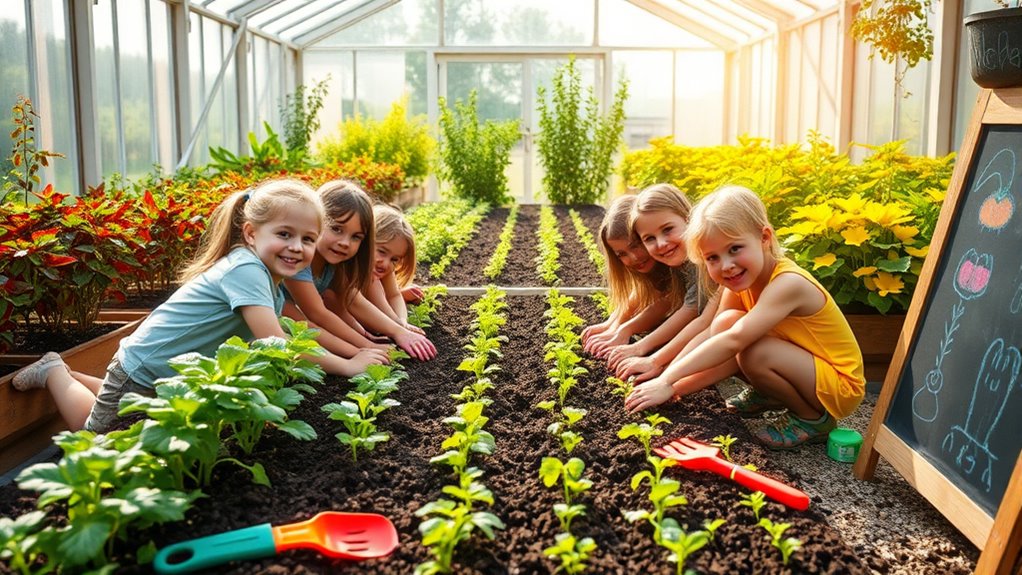
Greenhouses play an essential role in promoting environmental awareness among students, allowing you to connect directly with nature while learning sustainable practices.
You'll engage in hands-on experiences, from planting seeds to nurturing plants, which fosters a deep understanding of biodiversity and local ecosystems. Through activities like composting and organic gardening, you'll grasp the importance of sustainability and responsible behaviors. Greenhouses also serve as living classrooms, providing a unique environment for experiential learning that bridges theory with practical applications. Additionally, understanding energy efficiency through greenhouse operations can further enhance your knowledge of sustainable practices. Incorporating techniques like solar energy for greenhouse heating can exemplify the use of renewable resources in agriculture. The use of chia seeds in educational gardening projects can also promote discussions about nutritional benefits and sustainable food sources.
Greenhouses also introduce you to innovative techniques like hydroponics and aquaponics, emphasizing efficient resource use. By studying climate change and renewable energy within this setting, you'll develop critical thinking skills and a sense of community responsibility.
Ultimately, these experiences shape your perspective on environmental stewardship, empowering you to make a positive impact in your community and beyond.
Integrating Greenhouses Into Various Curricula
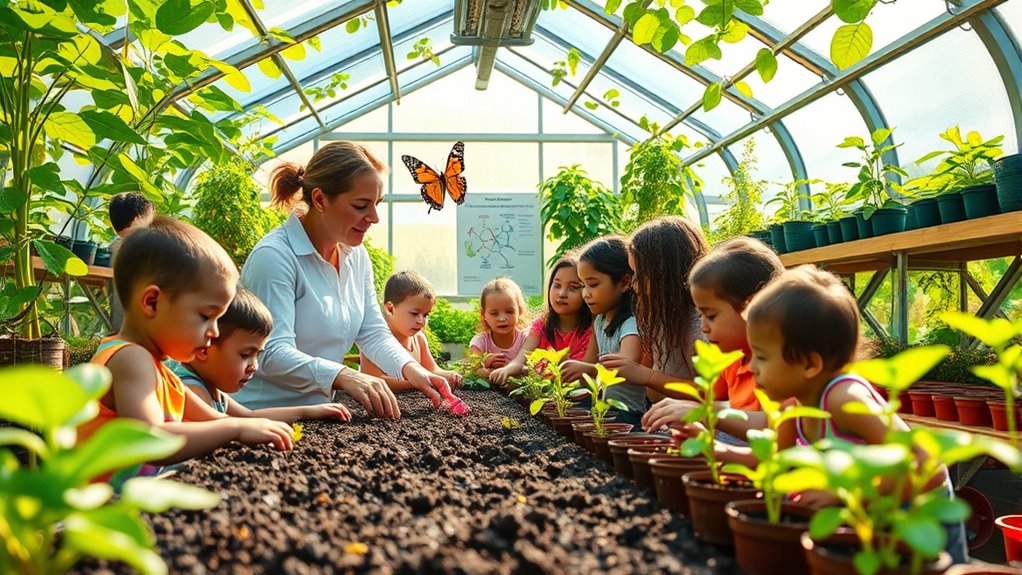
While exploring ways to enhance learning, integrating greenhouses into various curricula can provide students with unique, hands-on experiences that bridge theoretical concepts with real-world applications.
In STEM education, you can study plant biology, photosynthesis, and environmental science while using technology to track growth conditions. Bee foraging range can be observed to understand pollination dynamics as students learn about the role of pollinators in plant growth. Engineering projects can focus on designing efficient systems like hydroponics, and you can analyze data to apply mathematical concepts. Greenhouses also serve to address global issues such as climate change and food insecurity, reinforcing the importance of sustainability in education. Utilizing energy-efficient models in greenhouse designs can further enhance sustainability and reduce operational costs. Additionally, students can explore the benefits of solar panels in powering greenhouse systems, promoting energy independence and reducing environmental impact.
In arts and social sciences, create art inspired by plant life, explore community engagement, or document experiences through writing.
Greenhouses also lend themselves to project-based learning, where you can conduct experiments, solve problems collaboratively, and engage in community service. This integration fosters critical thinking and nurtures a sense of environmental responsibility among students.
Addressing Food Sustainability in Schools

Incorporating greenhouses into educational settings not only enhances learning but also plays an essential role in addressing food sustainability in schools.
You'll find that school meal programs serve over 407 million children globally, promoting healthy food options and supporting local farmers. Yet, many schools struggle to provide consistent healthy meals. By utilizing self-watering planters in greenhouse programs, schools can ensure that plants receive adequate moisture, making it easier for students to engage in gardening activities. Additionally, understanding the importance of long-term financial planning for sustainable practices can help schools maintain these greenhouse initiatives. Implementing sustainable building practices in the design of these greenhouses can further enhance their effectiveness and longevity.
By integrating greenhouse programs, you can teach students about sustainable agriculture and food production. These initiatives often focus on climate-friendly foods and reducing food miles, boosting local economies. Furthermore, engaging with small-scale farmers fosters community connections and encourages healthier food preferences. As you work towards creating sustainable menus, you'll also enhance students' health and well-being, paving the way for a more sustainable future. Additionally, incorporating nature-based solutions like greenhouses can further educate students about the importance of sustainability and environmental stewardship.
Fostering Innovation and Creativity in Students
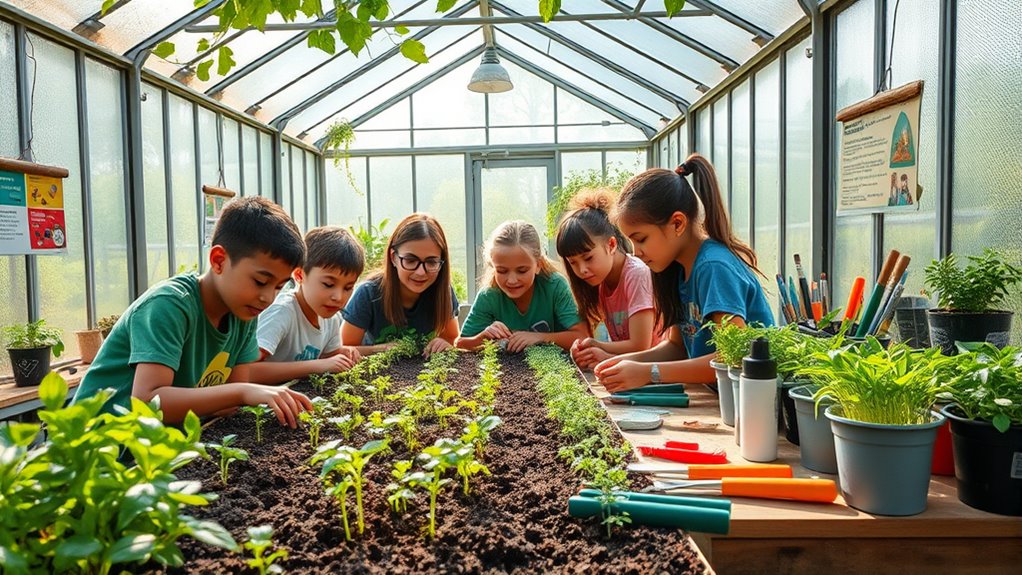
As students engage with greenhouse projects, they not only deepen their understanding of sustainable practices but also ignite their innovation and creativity.
These hands-on experiences allow you to apply theoretical knowledge to real-world scenarios, enhancing problem-solving skills as you tackle challenges like temperature regulation. Working in a greenhouse, you integrate various disciplines, fostering extensive understanding. Additionally, the living lab model provides a unique opportunity for students to collaborate with professionals in sustainability efforts. This collaboration encourages creative practice, allowing students to explore diverse solutions to complex problems. Furthermore, learning about backyard greenhouses equips students with practical skills that can be utilized in their own homes and communities. In this context, understanding the importance of routine health checks can help students appreciate the interconnectedness of sustainable practices.
Design challenges stimulate your creativity, pushing you to propose innovative features like rainwater catchers. You experiment with technology, learning about automation systems that enhance efficiency.
This collaborative environment promotes teamwork, making you feel a sense of ownership and pride in your work.
Ultimately, greenhouse projects cultivate an innovative mindset, preparing you for future challenges in sustainability and beyond.
Building Community Connections Through Greenhouse Initiatives
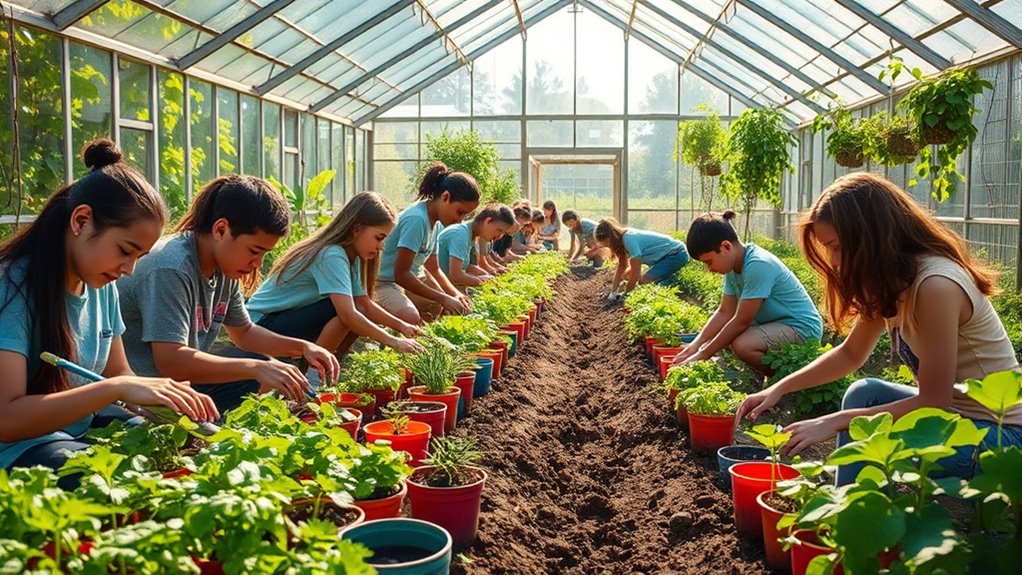
Greenhouse initiatives not only enhance students' learning experiences but also strengthen community ties, creating a vibrant network of support and collaboration. By engaging in events like farmer's markets and gardening workshops, you can build connections with local businesses and nonprofits, fostering partnerships that benefit everyone involved. Participating in outreach programs allows you to share your knowledge and promote sustainable practices within the community. Hosting events at the greenhouse creates a sense of belonging among students, teachers, and parents. Involving local stakeholders enriches these initiatives, encouraging a collective commitment to sustainability. These efforts can also help address the urgent need to combat climate change, which threatens both our environment and our communities. Additionally, smart shopping practices can support local agricultural initiatives, reinforcing the importance of sustainability in our everyday choices. Incorporating healthy meal options like the Turkey Bean and Tomato Zoodle Bowl can also inspire students to appreciate the benefits of sustainable food choices. Furthermore, educating students about water sources can enhance their understanding of the essential resources needed for successful gardening and farming practices.
Hands-On Learning Experiences in Plant Biology
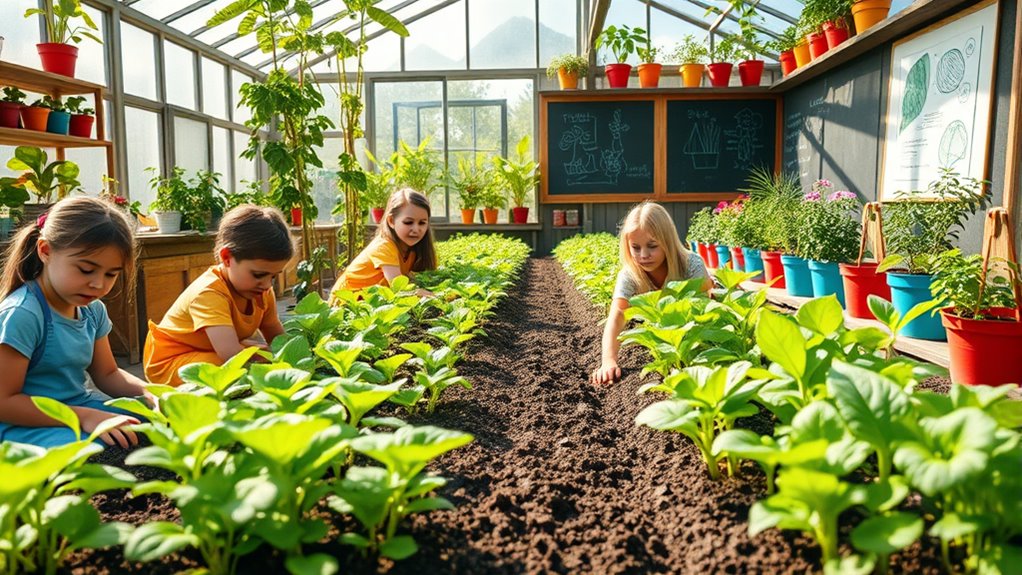
Hands-on learning experiences in plant biology can transform your understanding of the natural world. In a greenhouse, you'll observe and participate in plant growth, deepening your grasp of photosynthesis and plant anatomy. You can experiment with variables like light, temperature, and humidity, which sharpens your analytical and critical thinking skills. With diverse plant collections at your fingertips, you'll study biodiversity and ecosystems firsthand. Engaging in research opportunities allows you to explore advanced horticultural practices and innovative design for sustainable agriculture. Additionally, incorporating whole foods into your gardening practices can enhance the nutritional value of the plants you grow, promoting healthier eating habits. Plus, by integrating STEM concepts, you apply math and environmental science to real-world scenarios. Additionally, you will learn about sustainable gardening practices that contribute to broader environmental conservation efforts.
Furthermore, engaging in hands-on learning experiences not only enhances understanding but also prepares students for future careers in technology and engineering. These experiences don't just teach you about plants; they develop your problem-solving abilities and foster collaboration, setting the stage for a sustainable future in agriculture and environmental stewardship.
Exploring Advanced Agricultural Techniques
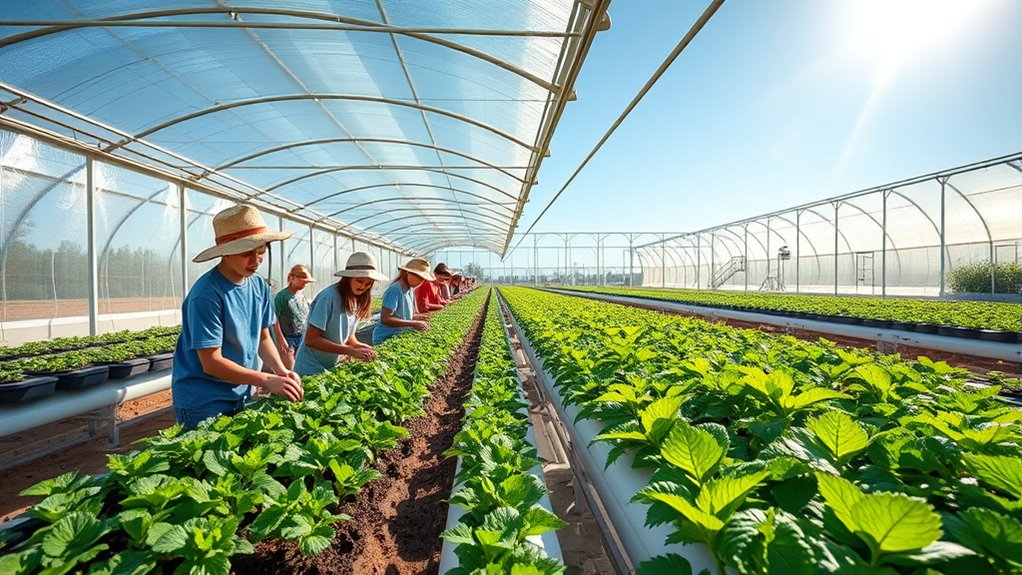
Advanced agricultural techniques are revolutionizing how we approach food production, especially in greenhouse settings.
You'll find that automation and smart technology streamline operations, enhancing productivity while cutting labor costs. With AI systems analyzing data, you can monitor crop health and environmental conditions effectively.
Implementing practices like hydroponics and aquaponics allows for efficient water use and year-round production, all while conserving land. Additionally, advanced irrigation techniques such as drip irrigation minimize water wastage significantly, promoting sustainability in water management. Moreover, the integration of energy-efficient technology ensures that greenhouse operations reduce their carbon footprint and promote sustainable practices. Heat pumps, for example, can significantly lower carbon emissions compared to traditional heating methods, enhancing overall sustainability. Furthermore, geothermal heat pumps achieve efficiency ratings of 300% to 600%, making them a superior choice for heating greenhouses.
Furthermore, precision agriculture guarantees your plants receive peak care through IoT technology, which adjusts temperature, humidity, and light based on real-time data.
By focusing on soil health management and smart greenhouse technologies, you can maximize crop yield and quality while promoting sustainability.
Embracing these advanced methods prepares you for a future where efficiency and environmental stewardship go hand in hand.
The Future of Education With Greenhouses
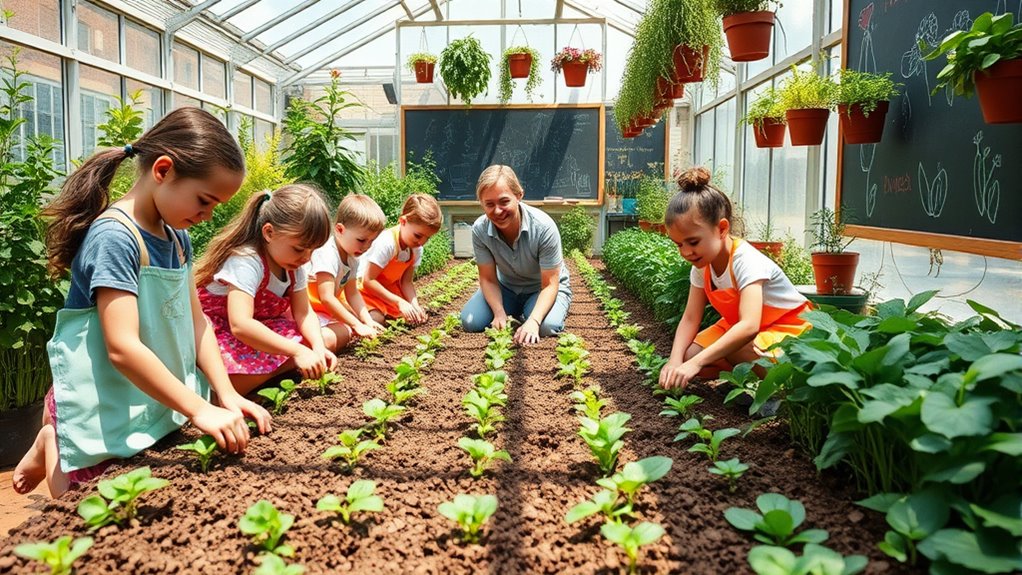
As education evolves, the integration of greenhouses into school curricula is becoming increasingly essential for fostering a deeper understanding of science and sustainability.
You'll find that greenhouses serve as living classrooms, enhancing your hands-on experience in STEM subjects. By monitoring temperature and humidity with smart devices, you bridge the gap between theory and real-world applications. Additionally, understanding emotional dysregulation can help students recognize the importance of maintaining a stable environment for plant growth.
These greenhouses also promote eco-awareness, teaching you about composting and biodiversity while integrating renewable energy systems. In addition, successful greenhouse programs can involve community members, fostering teamwork and shared responsibility among participants.
As you engage in interdisciplinary projects, you'll explore subjects from math to literature.
The future of education lies in expanding greenhouse programs, which will prepare you to tackle pressing environmental challenges while fostering community engagement and collaboration.
Embrace this opportunity to develop a lifelong sense of responsibility towards the environment.
Frequently Asked Questions
How Can Parents Get Involved With School Greenhouse Projects?
You can get involved with school greenhouse projects in several meaningful ways.
Volunteer to help with maintenance tasks like watering and pest control. Join workshops to learn about gardening and sustainability.
Assist with fundraising efforts or promote the project within the community. Collaborate with teachers on lesson planning and support hands-on learning experiences.
What Types of Plants Are Best Suited for Educational Greenhouses?
Imagine watching a tiny seed sprout into a vibrant plant, much like a child blossoming with knowledge.
For educational greenhouses, consider easy-to-grow plants like nasturtiums and basil, which engage students and yield quick results.
Climbing plants like morning glory can inspire creativity, while microgreens teach about rapid growth.
Scented geraniums and ferns add sensory experiences, making learning interactive.
Ultimately, these plants foster curiosity and hands-on learning in a nurturing environment.
Are There Grants Available for Establishing School Greenhouses?
Yes, there are several grants available for establishing school greenhouses. You can explore USDA grants like the Farm to School Grant Program, or look into Perkins Grants for career education.
Nonprofits like the Whole Kids Foundation also offer funding for educational gardens. Additionally, consider crowdfunding on platforms like GoFundMe or partnering with local businesses for support.
Don't forget to check Grants.gov for a broader range of federal opportunities.
How Do Greenhouses Impact Local Ecosystems and Biodiversity?
Imagine stepping into a lush greenhouse, where vibrant plants thrive under controlled conditions.
Greenhouses can greatly impact local ecosystems and biodiversity. While they support native species and pollinators, they also risk disrupting local habitats if managed poorly.
The balance of life teeters as intensive practices may lead to pollution and habitat loss.
What Challenges Do Schools Face When Maintaining Greenhouses?
When maintaining greenhouses, you'll face several challenges. Securing consistent funding is vital, as equipment and resources can be costly.
Staff turnover can disrupt operations, so establishing clear leadership roles is essential. Regular maintenance tasks like watering and pest control require commitment from volunteers and staff alike.
Additionally, integrating greenhouse activities into your curriculum can enhance engagement but requires careful planning to align with educational objectives.
Balancing these factors is key to your greenhouse's success.
Conclusion
As you step into a greenhouse, you're not just entering a space filled with plants; you're uncovering a world of possibilities. These vibrant environments spark curiosity and ignite passions for sustainability in students. By blending hands-on learning with advanced agricultural techniques, you're shaping a future where innovation meets environmental stewardship. Coincidentally, each seed you plant today grows into a commitment to a greener tomorrow, ensuring the next generation thrives in harmony with nature.
